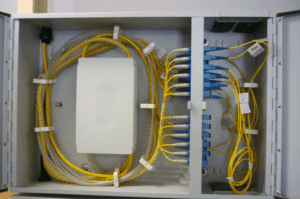‘Have you frozen?’ – Things to think about when upgrading your business broadband.

How many times have you uttered the phrase ‘have you frozen?’ during a video conference. It’s that moment when you are talking to someone on Zoom or Teams and you realise they haven’t moved for a while, usually in a fairly unflattering pose. Next you get that irritating feeling they are about to vanish and then it’s panic time while you wait for the internet to come back. In our experience it always seems to happen just after someone says the words ‘OK, this is really important…’ or similar. One of the main reasons for this annoyingly frequent problem is that you need to upgrade your business broadband.
What’s the difference?

The main differences between home and business broadband are probably not going to come as a surprise. In most cases business broadband is faster than home broadband. There are a few reasons why this is the case but one of the main ones is a fundamental difference between business and domestic broadband supply. With business the number of users in the system is usually lower. Fewer people ‘in the pipe’ means less congestion and that means less traffic to slow things down. People often ask why this is the case when it is possible to have both domestic and business broadband in the same building. Well, again there are a few factors but a common one is that business lines have priority over the traffic. That means when Billy up the road is multi-screening 3 episodes the latest Netflix blockbuster and playing his PS5 at the same time as his sister in the next room, they are not using the space allocated to business users.
That isn’t the whole story though because in the above scenario the business is using a standard line. That isn’t always the case.
What are FFTC and FTTP and do they matter?
Let’s answer the last part of that questions first. Yes, they matter if you want great broadband connections.
 FTTC is the abbreviated term for Fibre To The Cabinet (those boxes at the end of your street) and means that the broadband is coming in via a mixture of the old copper cables and new fibre optic connections. It’s quite fast and it works pretty well. It’s also readily available in most built up areas, particularly where this is a nearby residential supply. The downside of it is that it is really patching fibre on the old networks. The old systems are inherently copper wire based and not made for high-speed data transfers. It can be unstable and subject to intermittent speed fluctuations as a result.
FTTC is the abbreviated term for Fibre To The Cabinet (those boxes at the end of your street) and means that the broadband is coming in via a mixture of the old copper cables and new fibre optic connections. It’s quite fast and it works pretty well. It’s also readily available in most built up areas, particularly where this is a nearby residential supply. The downside of it is that it is really patching fibre on the old networks. The old systems are inherently copper wire based and not made for high-speed data transfers. It can be unstable and subject to intermittent speed fluctuations as a result.
FTTP means Fibre To The Premises and means that the business is attached via fibre optic cables only. That means a couple of important things. Firstly, it’s potentially more stable and will suffer less from variable speeds. Secondly, it’s usually going to be a lot faster because there is no copper element to the transfer.
Do you need FTTP and if so, why?
Again, short answer is probably, yes if you need fast, reliable broadband. It is often slightly more expensive but to be honest, if you need the benefits it brings, it has definite value. In terms of future proofing then it is clear ‘yes’. Business broadband packages come with higher service levels as well, which usually guarantees less downtime and better, more consistent, service.
What about work from home employees?
 This is an interesting question. Since lockdown made Working from Home (WfH) a standard practice, domestic internet access has taken on a new level of importance. Many businesses are offering to upgrade the residential broadband of directors and key employees with business service. Business level broadband makes WfH considerably more reliable and if you couple that with an FTTP installation you can work via cloud services easily, efficiently and often in a very cost-effective way. As with any business decision it all about the ROI and the benefits but it is well worth looking at if you intend to continue a WfH policy.
This is an interesting question. Since lockdown made Working from Home (WfH) a standard practice, domestic internet access has taken on a new level of importance. Many businesses are offering to upgrade the residential broadband of directors and key employees with business service. Business level broadband makes WfH considerably more reliable and if you couple that with an FTTP installation you can work via cloud services easily, efficiently and often in a very cost-effective way. As with any business decision it all about the ROI and the benefits but it is well worth looking at if you intend to continue a WfH policy.
Call if you want to talk through your telecom options or drop is a message and let’s see how we can help.

